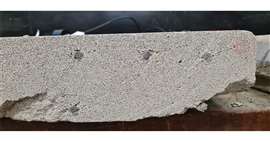Industry experts speak on RAAC
05 September 2023
 A RAAC panel in cross section (Image supplied by Loughborough University)
A RAAC panel in cross section (Image supplied by Loughborough University)
More than 100 schools in England have been told to fully or partially close because they are fitted with a concrete that could suddenly collapse, as previously reported in Construction Europe.
Reinforced autoclaved aerated concrete (RAAC) is a lightweight building material used from the 1950s up to the mid-1990s, but is now assessed to be at risk of collapse. It is not just used in schools, but in hospitals and other buildings.
Before the recent controversy surrounding it, a report by the UK’s spending watchdog, the National Audit Office (NAO) highlighted the cost and complexity involved in dealing with RAAC. The government has committed to completely rebuild seven ‘structurally unsound’ hospitals built with RAAC that are now in urgent need of replacement, as part of a wider hospital building programme in England. Each hospital is expected to cost in the region of £1 billion (US$1.3 billion).
What is RAAC?
Professor Chris Goodier, an expert in construction engineering and materials at the University of Loughborough in the UK gave his view on the subject. Goodier is part of a team leading a major research project on RAAC funded by the NHS and advises several other major government departments.
“RAAC is an aerated lightweight cementitious material with no coarse aggregate; the material properties and structural behaviour differs significantly from ‘traditional’ reinforced concrete,” he said.
“It is essential that those responsible for the management, maintenance or alteration of buildings know whether their buildings contain RAAC, and if they do not know, they should seek appropriate expert advice. If not properly managed, RAAC planks are structural building components with safety implications. RAAC is still manufactured and installed all over the world and Goodier maintains that it can still be an appropriate construction material, so long as it is properly designed, manufactured, installed and maintained,” he added.
“Our research has shown, however, that this is often not the case for RAAC panels constructed in the 1950s, ‘60s, and ‘70s,” he said.
Is RAAC a global issue?
Manufacturing in the UK stopped at some point in the 1980s and, although it is not clear exactly why, researchers believed that it was recognised that the material could be prone to problems.
However, RAAC wasn’t just used in the UK. It was also popular in Ireland, Australia, New Zealand and South Africa from the 1950s to the 1980s. It is unlikely that RAAC manufactured in countries other than UK will be without similar problems.
Goodier’s colleague at Loughborough University is Chris Gorse, professor of construction engineering and management. He is also working on the NHS cross-government programme of research into RAAC plank performance.
Speaking to International Construction earlier this year, Gorse said, “We have found problems with RAAC’s manufactured during the 1950s, 1960s and 1970s. I suspect that that inconsistency in manufacturing may have been replicated overseas.”
Gorse pointed out that RAAC, when manufactured, installed and maintained properly, still performs well. “We haven’t tested an existing panel, even when it has been in service for a time and where it has got adequate end bearings, that has failed below its design strength,” he said.
But that is part of the reason why inspection of RAAC, before deciding on whether RAAC needs to be remediated or in some cases even replaced, is so important.
“I think RAAC, during its manufacture and assembly was probably more exposed to abuse,” Gorse said. “The presence of water does change its behaviour, as well as leading to corrosion and potentially spalling of the concrete. But it is also based on the way it was manufactured, whether the steel reinforcements were in the right place, and whether it has been exposed to greater loads than it should have been.”
This is an edited version of a longer read that first appeared on the Construction Briefing newsletter. Sign up to recieve the newsletter for free.
STAY CONNECTED



Receive the information you need when you need it through our world-leading magazines, newsletters and daily briefings.
CONNECT WITH THE TEAM








